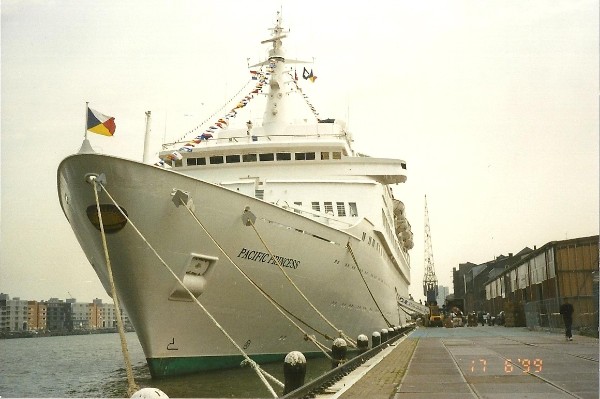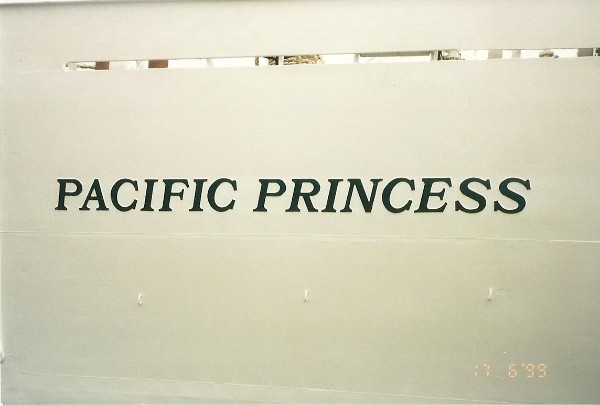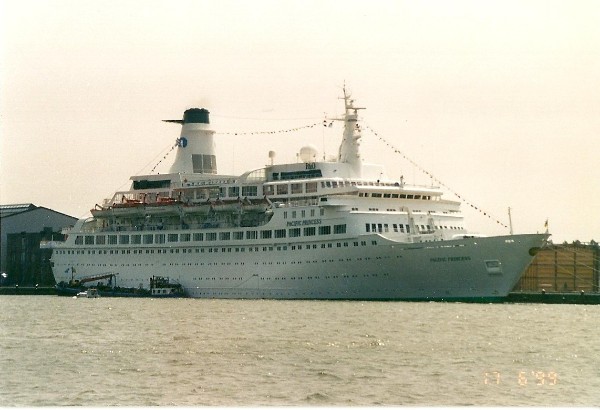Pacific Princess (I)
The new Sea Venture had one sistership that was built one year later and she was called Island Venture. The ship had a lenght of 168,74 meters, a with of 24,64 meters and her draft was 7,70 meters. Her tonnage was 20.186 and she was a typical example of the ships built in this period. She could accomodate 644 passengers and 317 crew on seven passengerdecks.
Below, Pacific Princess is seen at the Noordelijke handelskade in Amsterdam at the 17th of june 1999, before there was even a cruiseterminal here. Because of that, it was very easy to get onto the quay itself and take pictures like this, something that is nowadays impossible.

Sea Venture was built for the Norwegian company Norwegian Cruiseships for management by Flagship Cruises, a US based firm. She was launched at the 14th of may 1971 from the Rheinstall Nordseewerken in Emden in Western Germany as yardnumber 411. The ship started cruising mostly from the US to Bermuda. And that was also where her name came from, because in july 1609, the survivors of the British ship Sea Venture were washed ashore here, after their ship had been in huge problems during a storm and their captain deliberately sailed the ship on the rocks of an island that proved to be Bermuda. The tale of the survivers was later the inspiration for Shakespeare's play 'The Tempest'.
In 1974, she rescued the passengers from the large Queen Elizabeth 2 after their ship had been struck by a complete failure of the machinery near Bermuda. For this, Sea Venture left her own passengers at Bermuda so she had room enough for the Queens'. In that same year, both Island Venture and Sea Venture were bought by P&O Cruises and added to the fleet of Princess Cruises, that was just bought by P&O. Island Venture was renamed Island Princess and Sea Venture was renamed Pacific Princess, although she was not only meant for Pacific cruises. She was delivered to P&O under her new name at the 7th of april 1975.

Aaron Spelling, a famous TV-producer, approached Princess Cruises with the idea of a television series about a cruiseship and its crew just after these ships entered the P&O Princess fleet. P&O at first was very sceptical about this idea, but they later recognized the potential of this opportunity and they decided to let Spelling use their ships for the series that of course was to be The Love Boat. The series became very popular and were the true beginning of the cruise boom in total. The humoristic show debuted on the 24th of september 1977 on the saturdaynight of ABC. It was based on a TV movie with the same name that itself was based on the book 'The Love Boats' by Jeraldine Saunders, a true-life cruise director. The show ended in 1986 but its influence had been enormous. Princess Cruises was now one of the most well known names in the cruising industry, although other ships like the Stella Solaris of the Sun Line and her sistership Island Princess were also used sporadicly. Cruising, that had been only for the rich and wealthy, was now possible for more people because the series created a huge growth in interest for a sea voyage. It is fair to say that the current growth of cruising is at least helped in a great way by this series.

And of course the Pacific Princess became a ship everybody loved and she sailed steady on for Princess Cruises. She did not have to cope with many problems, with the exceptation of a drug raid that was carried out in Piraeus, Greece in 1988. The ship was believed to be a tool for drugrunners and that supposed to be true, because some 25 kilos of heroin was found on board and two Filipino crew members were arrested.
In 2001 the Princess fleet had been growing in size for years and Pacific Princess was outdated by her newest fleetmates. Although still popular, mainly also because The Love Boat was still playing in some countries, the ship was sold to Viagens CVC, although she had been chartered back to Princess to sail her 2002 season.
Her last cruise for P&O Princess, that itself had left the P&O group two years earlier, started at the 27th of october 2002. After that, she was chartered out to Pullmantur Cruises of Spain and started sailing as their Pacific. She was later chartered out to CVC Cruises (Brazil) in winter and to Quail Cruises (Spain) in summer under the same name.

At the end of 2011, the ship was taken out of service and laid-up at Genoa to be rebuilt. In march 2013, it was announced that she was finally sold for breaking at Aliaga, Turkey and she left in tow of the tug Izmir Bull on july 27th that same year for her final destination, renamed Acif. Sadly, the ship was badly heeling over while reaching her Turkish graveyard due to leaks in her hull. To be safely scrapped, she was rightened up, but afterwards she again listed heavily making scrapping a dangerous operation. We can say the former Love Boat is protesting against a sad end for such a fine and beloved vessel.

